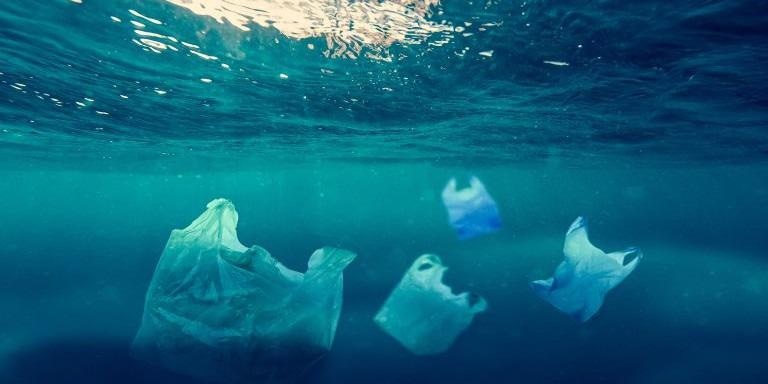Plastic packaging waste can be seen everywhere. Plastic bottles, food wrappings, and grocery bags used by humans litter the landscape and contaminate the global environment.
 Plastic packaging waste pollutes the world’s oceans. Image Credit: pixahive.com.
Plastic packaging waste pollutes the world’s oceans. Image Credit: pixahive.com.
Plastic waste from all over the world is carried by currents to converge in the Pacific Ocean near Hawaii, forming the Great Pacific Garbage Patch, which is twice the size of Texas. The floating waste degrades into microplastics, which are subsequently eaten by fish and then consumed by humans who eat those fish.
Only 14.5% of US plastic waste has been recycled and the majority of it ends up in landfills where it takes hundreds of years to degrade. The United States and other developed countries have conventionally shipped their plastic waste to Asia. However, several developing countries at present now refuse to accept more waste.
A new study performed by an international group of scientists explores the international patterns of plastic packaging waste. The study determines three countries — the United States, Brazil, and China — to be the top suppliers of waste.
We wanted to follow the plastic packaging waste embedded in the global supply chain. This work allows us to conclude the problem is a responsibility shared between economic agents, from the producers and their intermediaries to the retail stores and the consumers.
Sandy Dall’erba, Study Co-Author and Professor, Department of Agricultural and Consumer Economics (ACE), University of Illinois
Dall’erba is also the director of the Center for Climate, Regional, Environmental and Trade Economics (CREATE).
Dall’erba and his collaborators quantified plastic packaging waste transaction flows depending on a global, multiregional input–output database known as EXIOBASE, integrated with World Bank data.
The scientists discovered that North and South America collectively produced around 41% of the world’s production of plastic packaging waste, primarily from the United States (19% of world production) and Brazil (13%).
Europe is next on the list with 24%, and Asia follows with 21%, among which, the majority has been generated in China (12%).
When it comes to consumers, North and South America are once again responsible for the majority of the waste generated. Jointly, the Americas represent 36% of the global plastic packaging consumption, which has been followed by Europe at 23% and Asia at 26%.
High-protein food such as meat, fish, and dairy is a trademark in the Americas and those generate a lot of plastic packaging waste. For instance, every 1 kg (2.2 lbs.) of fish consumed will lead to an average of about 1.6 kg (2.5 lbs.) waste. This includes plastic bags, trays, and cellophane used to wrap and cover the fish during transportation, storage, and sales.
Sandy Dall’erba, Study Co-Author and Professor, Department of Agricultural and Consumer Economics (ACE), University of Illinois
Additionally, international exports worsen the issue, accounting for nearly 25% of global plastic packaging waste.
Plastic is not easy to replace. There is no other material to protect the freshness of a food product that will be shipped around the world. We need to further develop technologies that make plastics more biodegradable, such as products based on algae. But we also need stricter regulations to discourage plastic packaging production and use.
Sandy Dall’erba, Study Co-Author and Professor, Department of Agricultural and Consumer Economics (ACE), University of Illinois
International agreements like the Kyoto Protocol concentrate on limitations and fees on production. However, that gives developed countries a powerful incentive to relocate the majority of the polluting activities to developing countries. At the world level, it’s a zero-sum game, because you just delegate the problem to another place, Dall’erba notes.
Scientists come to a conclusion that producers and consumers should share charges and responsibility.
“All agents along the supply chain and final consumers need incentives to reduce plastic use. Some examples are taxes on waste management or refunds for returning plastic bottles,” explains Xiang Gao, the paper’s lead author.
Gao is a researcher at the Academy of Mathematics and Systems Science, Chinese Academy of Sciences (CAS) in Beijing, China.
Gao added, “Other steps include banning of single-use plastic straws, or imposing fees for grocery store plastic bags. Consuming locally grown, seasonal food would help, and so would better transparency about the true recyclability associated with the resin identification code stamped on plastic packaging.”
This study was financially supported by the Department of Agricultural and Consumer Economics, the Center for Climate, Regional, Environmental and Trade Economics (CREATE), the National Natural Science Foundation of China, and the Chinese Scholarship Council.
Journal Reference:
Gao, X., et al. (2022) When one cannot bypass the byproducts: Plastic packaging waste embedded in production and export. Journal of Industrial Ecology. doi.org/10.1111/jiec.13282.